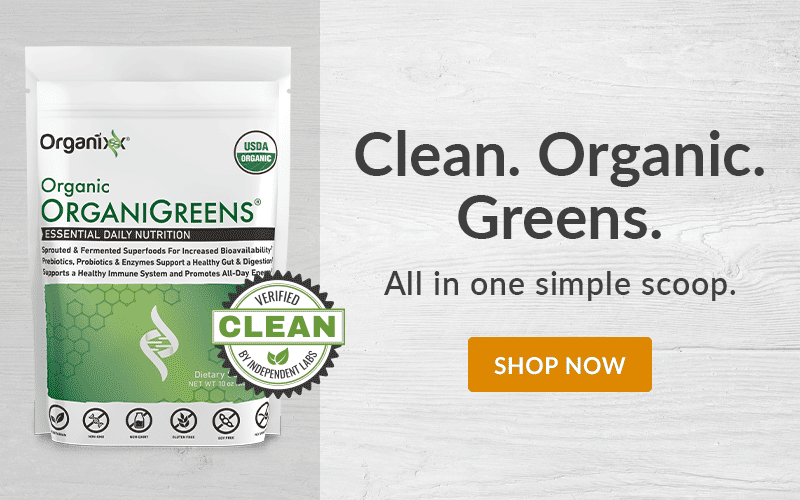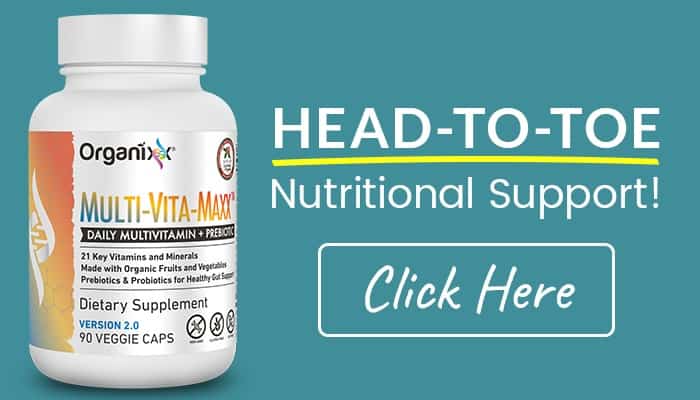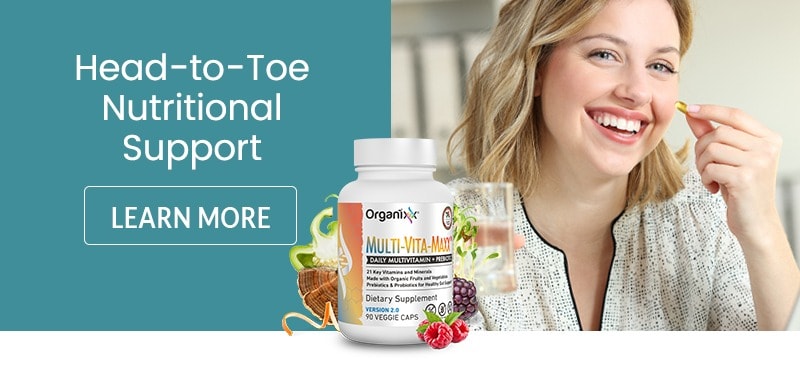Leafy greens are a go-to source of nutrition for those who are in the know about health. It’s no secret that putting more kale, chard, arugula, romaine, and spinach on your plate just makes good sense when you’re trying to be healthier. Spinach is one leafy green that’s readily accessible and particularly beneficial for both your body and brain. How many of these super health benefits of raw spinach (including detoxification) are you aware of?
What Nutrients Are in Spinach?
First, let’s talk about the basics – all those essential vitamins and minerals that are found in spinach that can aid your health in every way.
Spinach has healthy amounts of vitamin A, in the form of beta-carotene. It’s also packed full of vitamin K. In fact, a mere cup of raw spinach contains 181% of the recommended daily intake (RDI) of vitamin K [1]!
Spinach also contains vitamin C and many forms of B vitamins, including B6, B12, folate, and pantothenic acid. In addition, it provides many essential nutrients such as choline and betaine as well as key minerals like manganese, potassium, magnesium, and a healthy amount of iron.
Low in Calories, High in Fiber

In addition to all the above nutrients found in spinach, it also contains about 3 grams of protein for every 100 grams of veg and about 2 grams of fiber. Spinach has a very high water content and only about 22 to 25 calories for every 100 grams [2].
The fact that raw spinach is:
- high fiber
- high water
- low calorie
- and nutrient-dense
makes it a true superfood (and perfect diet food) in every way!
3 Unique Antioxidants Found in Spinach Leaf
Some of the other major health benefits of eating spinach come by way of its powerful antioxidants. Antioxidants from whole foods are essential in today’s toxic world. They help to clear oxidation and the damage that too many free radicals can do on the genetic level when they are left to proliferate unchecked (i.e., premature aging).
Here are just three of the many unique antioxidants found in spinach:
#1. Alpha Lipoic Acid (ALA)
ALA, which comes from magnesium, is especially beneficial for those suffering from diabetes since it helps to balance blood sugar levels. ALA has also been shown to have strong anti-inflammatory properties.
#2. Lutein

Too much time in front of the computer, seasonal allergies, and getting older can all have a negative effect on eye health. Lutein is one of the most important phytonutrients to help in this regard and spinach has it in spades.
According to the authors of a 2018 meta-analysis, “a large body of evidence shows that lutein has several beneficial effects, especially on eye health [3].”
#3. Quercetin
Spinach is a natural source of quercetin, a super antioxidant that has been connected in recent research to the reduction of chronic disease. The experts at Memorial Sloane Kettering Cancer Center explain that quercetin can work as a chemoprotective substance against cancer cells and also as an anti-apoptotic agent for healthy cells, protecting them from destruction.
Quercetin also has metabolic benefits and has been found to be helpful for those with arthritis [4].
Are the Nitrates in Spinach Healthy or Harmful for You?
No doubt you’ve heard of nitrites and nitrates that are used as preservatives, especially in commercial meat, and have likely been told to avoid them.

There are some good forms of nitrite, however, that first comes in the form of nitrates found in whole foods like spinach. When you chew a bite of food, like a spinach leaf, the chemical reactions that occur next convert this nitrate to nitrite which eventually changes into nitric oxide in the gut. This is when the magic happens.
Nitric oxide (NO) has been connected to:
- calming the nervous system
- helping the blood
- kick-starting metabolism
A 2014 study conducted by the Hypertension Institute in Nashville found that nitric oxide can “lower BP (blood pressure), improve vascular compliance, and restore endothelial function in patients with hypertension [5].”
Nitrates in Leafy Greens Like Spinach Are Good for Your Heart
For years the presence of nitrates and nitrites in foods had been associated with certain kinds of disease, especially cancer. Although this may be true for synthetically produced nitrate/nitrite preservatives that are added to foods, natural nitrates found in vegetables such as spinach are a whole different story.
In one 2011 review of scientific literature, researchers at the University of Texas concluded that the production of nitric oxide from certain foods can actually provide cardiovascular and cancer protection. According to the researchers, “the collective body of evidence suggests that foods enriched in nitrite and nitrate provide significant health benefits with very little risk [6].”
4 Health Benefits of Raw Spinach When It Comes to Detoxing Your Body
On top of all the health benefits of raw spinach related to its vitamins & minerals, antioxidants, and nitric oxide production… did you know that spinach actually helps your body detox at every level? Here are 4 key ways…
#1 – Help for the liver.

Spinach leaves contain chlorophyll, which is a phytonutrient that gives all leafy greens their dark green color. Chlorophyll has some pretty impressive benefits for humans as well since it is a powerful antibacterial and antifungal.
Chlorophyll has also been shown to have anti-inflammatory and anticancer properties. One investigation conducted by Johns Hopkins Bloomberg School of Public Health and published in the Proceedings of the National Academy of Sciences found that the substance chlorophyllin, which is derived from chlorophyll, can help reduce DNA damage that is associated with liver cancer [7].
#2 – Detoxing the colon.
The fiber in spinach can definitely contribute to a healthier colon. Another factor for gut health, in general, is the high amounts of vitamin C and A (in the form of beta-carotene) within spinach.
Recent research has found that key forms of B vitamins (mainly folate) can help to protect the intestinal tract from damage on the genetic level and may provide relief and healing for gastric ulcers as well.
A 2020 investigation conducted at University of Tokushima in Japan found that substances called glycoglycerolipids found in spinach can increase GI tract lining strength. This is vital for clearing up many conditions that are associated with leaky gut (intestinal permeability) and other GI tract disorders [8].
#3 – Promoting brain detoxification.
In this toxic world, it’s important to be proactive when it comes to helping your liver, which is your primary organ of detoxification.

New research in neurodegenerative diseases has shown that the brain also needs our active participation in getting rid of toxins that may contribute to brain fog, anxiety/depression, memory loss, cognitive decline, and more serious conditions such as Alzheimer’s Disease.
In fact, Alzheimer’s prevention is one of the key benefits of eating more spinach. According to a study at Rush University, amongst others, eating green leafy vegetables can slow cognitive decline [9].
Low folate levels also contribute to the disease, and spinach has an ample amount of that as well. Other key vitamins in spinach that can help with brain detoxification (and increase brain function) are vitamin C and K.
Spinach also contains high levels of zinc, as well as magnesium (mentioned earlier). Both of these essential minerals are essential for healthy circadian rhythms (your sleep-wake cycle) [10].
#4 – Boosting immune function.
All of the good effects mentioned above add up to a real boost for your immune system. A major study conducted by the Babraham Institute found that green leafy vegetables such as spinach can influence certain white blood cells that play a role in both gut health and infection-fighting. Remember that without a strong immune system, many pathogens can go undetected and never be eliminated [11].
The immune system is intimately connected to detoxification in the blood. The iron in spinach (as well as in all green leafy veggies) helps to replenish red blood cells. Infused with extra oxygen, the blood is detoxified and the whole body becomes energized.
Bonus Health Benefit of Spinach: Healthier-Looking Skin!

A happy (but not insignificant) side note is what this green leafy can do for your skin. The antioxidant combo found in spinach can even help to clear up acne (Acne vulgaris). A human trial published in the journal Cutaneous and Ocular Toxicology found that whole foods (like spinach) that contain vitamins A, E, and the mineral zinc can help those with the severest cases of acne [12].
Other blemishes and redness have been shown to reduce as well. This is because spinach contains several key substances, such as omega-3 fatty acids, that can aid in lowering inflammation overall [13].
Get Some Spinach in Your Daily Diet to Begin Detoxing Today!
Leafy greens are a must for everyone wanting to live a healthier, more vibrant life. In addition to lots of fresh spinach salads, raw spinach is an excellent addition to smoothies, soups, and stir fry. Adding spinach to your daily diet can help support your body’s natural detoxification system, as well as provide key nutrients, minerals, and antioxidants – all adding up to amazing health and immunity benefits and healthier-looking skin.
Organixx Cleanse & Detoxx is a two-step formula that provides a gentle yet powerful full-body detox using organic botanical ingredients. Naturally purge your body of toxins, chemicals, free radicals, heavy metals, waste, as well as bacteria, and pesticides. Easily cleanse your colon, liver, kidneys, lungs, and lymphatic system resulting in increased energy, and better digestion with more nutrient absorption, in addition to improved immunity, mental clarity, and overall health and wellbeing.
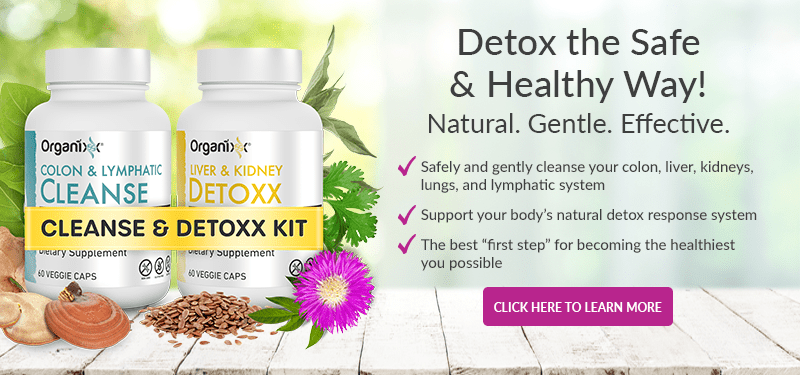
When you think of alfalfa, you may imagine sleepy cows chewing their cud out in the pasture. But did you know that this green grass we so often think of as “hay” is actually a powerful superfood? In fact, alfalfa has been used medicinally for people for longer than it’s been used in agriculture! Here’s the lowdown on alfalfa health benefits and the amazing phytonutrients available within each blade of grass or sprout.
Alfalfa’s Healing Properties Have Been Known for Thousands of Years

Alfalfa (Latin name Medicago sativa) is also commonly known as lucerne, particularly in Europe. Long before agriculture came to be the norm the world over, this plant – which is technically a legume – was used by ancient cultures as a powerful herbal medicine.
It originally hailed from South and Central Asia. Many centuries ago, however, it made its way to other continents and now is grown all over the world as a staple feed for horses, cattle, and other livestock.
As a source of human nutrition, alfalfa has been grown and eaten in the form of sprouts for decades. It can also be juiced, dried, and taken as a tea or in supplement form.
So, why would someone want to consume plain ordinary “hay” for their health? Read on to discover much more about the impressive alfalfa benefits for people and animals!
Benefits of Taking Alfalfa: Essential Vitamins & Minerals
Alfalfa is high in vitamin K and contains a number of B vitamins as well as vitamin C. It also contains an equal amount of many vital minerals needed for organ repair, bone development, brain health, and more.
Here is just a sampling of the dozens of essential vitamins and minerals found in 1 cup of alfalfa sprouts as well as their RDAs [1]:
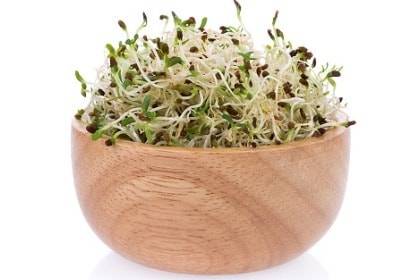
- Vitamin K, 13%
- Vitamin C, 5%
- Vitamin B2 (Riboflavin), 2%
- Vitamin B1 (Thiamin), 2%
- Vitamin B3 (Niacin), 1%
- Vitamin A, 1%
- Folate, 3%
- B5 (Pantothenic Acid), 2%
- Zinc, 3%
- Copper, 3%
- Manganese, 2%
- Iron, 2%
- Magnesium, 2%
- Calcium, 1%
- Potassium, 1%
Alfalfa also contains a solid amount of choline, betaine, sodium, and selenium.
Alfalfa Is a Major Source of Vitamin K
Of particular note is how much vitamin K can be found in alfalfa. Vitamin K is essential for healthy blood and helps to regulate clotting during injury. It is also a key helper for the absorption of both calcium and vitamin D. People with vitamin K deficiency often develop bone density issues such as osteoporosis and are also more susceptible to heart disease [2].

Interestingly, farmers have known about the vitamin K-blood health-alfalfa connection since at least the mid-1930s. A common practice for chickens, pigs, and goats who demonstrate blood or bleeding problems has been to feed them increased quantities of alfalfa hay.
A 1935 Danish study even found that chicken flocks dying of systematic hemorrhaging were saved when fed alfalfa. The key mechanism for the turnaround was the “koagulations vitamin,” or vitamin K, found in the new feed, according to a report published in the Journal of the American Medical Association [3].
Alfalfa Is Super-Charged With Phytonutrients to Lower Cholesterol
In addition to the basic yet vitally essential vitamins & minerals in alfalfa, it has also proven to be such a healer throughout the years because of the dozens of phytonutrients contained within it.
Saponins, phytoestrogens, coumarins, amino acids, digestive enzymes, and terpenes… there are literally hundreds of phytonutrients to be found in alfalfa.
Some of the most versatile and important of the phytonutrients found in alfalfa are saponins. “Sapo” means “soap” because saponins will foam up when they come in contact with water. Saponins are mild plant steroids that have been known to [4]:

Research has identified at least two dozen different kinds of these metabolism-boosting phytonutrients in Medicago sativa [5]. In particular, investigations both in the lab and on actual patients have found that saponins in alfalfa can have a significant impact on cholesterol levels [6].
These studies on humans go back over 25 years. One survey conducted in 1987 found that when individuals with high cholesterol levels ate 40 grams of alfalfa 3 times a day, their LDL cholesterol level (usually referred to as the “bad” cholesterol) was lowered by 17% after just 8 weeks [7].vii
Alfalfa is able to regulate cholesterol absorption in the gut. It also contains major antioxidants that support the detoxification organs. These are two key reasons for its success in helping to lower cholesterol by such a significant amount.
Alfalfa Health Benefits for Reproductive Health
Interestingly, alfalfa also contains key phytonutrients called phytoestrogens which may be of benefit to some women, especially during menopause.

A small yet impressive Italian study found that a mixture of sage and alfalfa extract given to women going through menopause led to the complete elimination of hot flashes and night sweats in 65% of the study participants. All of the other women experienced at least some reduction in these disruptive symptoms.
Contrary to popular belief, most women do not need to be afraid of consuming whole foods that contain phytoestrogens. This is because these plant substances mimic the milder forms of estrogen that actually work to protect the delicate balance of hormones in a woman’s body.
Phytoestrogens like the ones found in alfalfa also help to keep xenoestrogens at bay. Xenoestrogens come from environmental pollutants, pesticides, and other chemicals and will mimic the aggressive form of estrogen called estradiol that the body produces naturally. Xenoestrogen build-up is considered by many as the number one cause of many reproductive system cancers, such as breast cancer, in women today [8].
If you’re concerned about your estrogen levels and what whole foods, including alfalfa, may be of benefit to you, be sure to consult your natural health practitioner.
You Don’t Have to Eat a Lot to Reap Alfalfa Benefits
Of course, help for the metabolism and the hormones are only two of the advantages of adding alfalfa to your diet in some way. Other ways consuming alfalfa can help you is through [9]:
- supporting your immune system
- balancing insulin levels
- supporting the pancreas
- acting as a diuretic
- helping to dissolve kidney stones
- providing relief for arthritis
- increasing milk production in lactating women
What’s more, is that you don’t need to graze in a field or consume copious amounts of sprouts to take advantage of alfalfa’s health benefits.
Organic alfalfa powder is an ingredient in Organixx USDA Certified Organic OrganiGreens all-in-one daily superfoods supplement powder, made with 17 superfoods and botanicals, many sprouted or fermented to multiply and magnify their nutritional value, plus probiotics and enzymes for maximum absorption.
Just one scoop daily of Organixx OrganiGreens mixed into water, juice, a smoothie, or other recipe provides up to 6 times as much nutrition as other green drinks (and is so much easier than juicing!).
The latest formula of Organic OrganiGreens is our best yet. In just one simple scoop, add 17 sprouted and fermented superfoods and botanicals, plus probiotics and enzymes, to your daily diet to fill nutritional gaps and support healthy immune function, increased energy and mental clarity, as well as digestion and detoxification processes. Easily mixes in water, smoothies, juices, and recipes, and it also tastes great – even without any added sugars.

We made it through the bitter winter and now spring is upon us. Spring is traditionally the time of re-birth, growth, and a fresh new start. If you spent a little too much time “hibernating” through the winter, spring is also the perfect time to focus on getting your body “tuned up” through healthier eating habits.
With the warmer weather comes the first home-grown vegetables of the season − the cornerstone of any healthy eating regimen. Whether you’re tending to your own garden or taking advantage of your local farmer’s market, now is the time to dive in to spring’s bounties.
Here is a rundown of some of the most popular spring-time produce and why NOW is the best time to eat them for your health.
Why Eat What’s in Season?
 The truth is that our modern form of agriculture, with pesticide spraying, genetically modified crops, and over-tilling the soil, has wreaked havoc on the nutritional value of most common crops over the last 50 years.
The truth is that our modern form of agriculture, with pesticide spraying, genetically modified crops, and over-tilling the soil, has wreaked havoc on the nutritional value of most common crops over the last 50 years.
It’s a sad fact that the fruits and veggies prior to the 1950s contained way more nutritional value than the crops of today − even when you buy organic.
A comprehensive analysis of 43 typical crops grown between 1950 and 1999 conducted by the Biochemical Institute at the University of Texas and the Bio-Communications Institute in Wichita, Kansas, found that “reliable declines” in calcium, phosphorus, iron, vitamins B2, vitamin C and protein occurred over those 50 years for the crops they studied.
The researchers also concluded that the decline was in direct correlation with certain agricultural practices designed to improve traits such as size, growth time, and pest resistance − but not nutritional value.
There is some good news to come out of all this, however. Studies have also shown that the nutritional difference is wide between commercially-grown produce that is picked before it has had a chance to ripen (and then shipped hundreds of miles to the grocery store) and those that are allowed to ripen on the vine or on the ground and then shipped just a short distance before being offered and consumed.
They have also found that heirloom varieties of common crops like potatoes and carrots really pack a nutritional punch. For example, heirloom varieties of blue corn contain 99.5 milligrams of phytonutrients compared to commercially grown white corn, which has 1.54 milligrams of phytonutrients.
What all this means is that it is healthier, by leaps and bounds, for you to eat seasonally and eat locally as much as possible!
In Season Now: The Top 5 Powerhouse Spring Veggies
Although seasonal springtime crops will vary geographically, the following varieties are ready to be consumed in the spring across much of the U.S. If you cannot grow your own, that’s okay!
Help support your local farmer by paying a visit to your area’s farmer’s market. Just make sure that what you buy is organic and be sure to try out the heirloom varieties whenever you get a chance.
Remember that heirlooms may also represent some of the last traditional seed lines out there, as more and more commercial varieties are being grown through genetically-modified seeds, some of which have a “self-destruct” mechanism built into them.
This means that the farmer must purchase those same seeds year after year. With many locally-kept heirloom varieties, however, seeds can be harvested for the future the way nature intended them to… from growing plants, year after year.
#1. Asparagus.
Asparagus contains many good-for-you nutrients, including flavonoids quercetin and steroidal saponin. Quercetin has been linked to a reduced risk of heart disease and is also known for its anti-cancer effects as well as being a neuro-protectant.
Saponins are lesser-known flavonoids, which have been shown to play a role in immune system function and the regulation of inflammatory responses.
Asparagus is also high vitamin K and folate, two nutritional elements that the body needs for many functions. According to nutritional scientists, the best way to maintain all the wonderful nutritional components of your asparagus is to lightly steam it for no more than 3 minutes.
#2. Broccoli.
Broccoli is of the “cruciferous” vegetable family. All cruciferous vegetables (especially broccoli sprouts) contain the super-antioxidant sulforaphane, which many studies have confirmed contains anti-cancer effects, even against cancer stem cells.
Broccoli can also help support digestive health. Besides its high fiber content, the sulforaphane in broccoli also contains isothiocyanates (ITCSs) which help to protect the stomach lining from Helicobacter pylori overgrown in that area.
Broccoli also contains about a dozen other healthy nutrients, including vitamin C, vitamin B6, potassium, zinc, calcium, and selenium.
The best way to prepare fresh broccoli is to lightly steam for about 5 minutes. Also, note that broccoli is a “goitrogen,” so if you have a thyroid condition, it’s best to speak with your natural health practitioner about consuming it to allay any concerns.
#3. Brussels Sprouts.
Brussels sprouts seem to be all the rage these days, even showing up as the “appetizer of choice” at trendy restaurants and gastropubs. This is for good reason. They are absolutely delicious when sliced and lightly sautéed with real grass-fed butter and a little chopped garlic.
Nutrition-wise, Brussels sprouts are at the top of the list as well. They contain some unique properties, including DNA protection (through the blockage of certain enzymes, say researchers) and the phytonutrient glucosinolate, which has been shown to have cancer-protective effects.
Brussels sprouts are also very high in vitamin K, vitamin C and fiber. The particular kind of fiber in Brussels sprouts appears to be kinder to the digestive process than other cruciferous vegetables.
Also unlike other cruciferous vegetables, some studies have shown that Brussels sprouts may not have as much of an effect on thyroid function as broccoli, cabbage, cauliflower, and other cruciferous vegetables.
A report published in the journal Human and Experimental Toxicology found that inclusion of cooked Brussels sprouts into the diets of healthy individuals for 4 weeks had no effect on their thyroid. It should be noted, however, that this test was not done on individuals who already had imbalanced thyroid function.
Nevertheless, this study, and others, has led some experts to conclude that cooked Brussels sprouts may be a safe and super-healthy vegetable for those with thyroid conditions such as hypo- or hyperthyroidism.
For a different and decidedly delicious salad option, check out our Brussels Sprouts Sunshine Salad recipe.
#4. Beets.
Beets contain betalains and vulgaxanthins, unique phytonutrients that have strong antioxidant, anti-inflammatory, and detoxification effects. Regarding detoxing, beets really shine.
They can help support “Phase 2 detoxification,” which aids in glutathione production. Because of this, studies have also shown that consuming beets may protect against radiation exposure and poisoning.
Beets can be boiled, steamed, shredded, and eaten raw or juiced along with some lime, green apple, leafy greens, and a little ginger for a refreshing morning detox and energizer.
For a fun snack or side dish idea, try these Colorful Beetroot Chips.
#5. Dandelion.
Wait… do you mean those weeds with the yellow flowers that are taking over my backyard? You got it! Dandelions spread a wide net. They grow just about anywhere in the U.S. beginning in mid-springtime and can pop up (whether you want them to or not) throughout the summer.
What you may not know is that dandelion is not just a pesky weed. It’s a true powerhouse of nutrition!
Dandelion root and leaves contain calcium, vitamin A, antioxidants, and fiber. Dandelion also helps to cleanse the liver and kidneys, and studies show they have benefits for those with diabetes as well as those with stomach conditions and urinary tract disorders.
It should also be noted that dandelion has been known to work on the bowels and can have a laxative effect. Dandelion may also interfere with antibiotic absorption. If you are unsure, talk to your healthcare provider.
Other Veggies in Season
Additional vegetables you may find at your local farmer’s market (or in your own backyard) right now that pack a nutritional punch are:
- carrots
- cabbage
- bok choi
- artichoke (Western states)
- radish
- spinach
Get on the Farmer’s Market Bandwagon. It’s Good for You and Your Community!
Many Americans are catching “Farmer’s Market Fever” and you may even be one of them! This is very good news. A study conducted by Cornell University found that between 1994 and 2006, the number of functioning seasonal and year-round farmer’s markets in the United States more than doubled.
Approximately 3 million Americans shopped at them and about 30,000 small farmers and food entrepreneurs earned either a part-time or full-time living selling their produce at farmer’s markets in 2006.
More than likely, these numbers have gone up over the last decade, as more and more individuals “take to the streets” (i.e. the Farmer’s Market streets). Eating what’s in season in your local area just “feels right” to a growing number of people. That’s because it is… both for the body and for the local economy as well.



